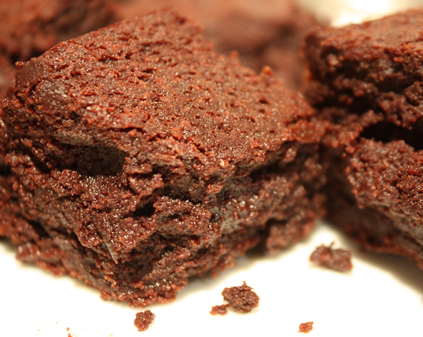
Sometimes you can’t beat an intense chocolate hit, and these brownies should satisfy even the most seemingly insatiable craving. This is Nigel Slater’s recipe, one I saved from a Sunday supplement years ago. Who doesn’t love Nigel Slater’s writing? He wrote this to tie-in with the Glastonbury Festival, and in his preamble to the recipe he says, “I don’t brag about my brownie recipe, or make extravagant claims for it; I just think it is a good as recipe as you will find” – and he’s right. It is devoid of fuss and frivolity, but it works perfectly and the taste and texture just knock your socks off. Pure cookery gold.
The quality of your ingredients will very much dictate the quality of the finished article.
Nigel Slater’s Chocolate Brownies, from the Observer Magazine, 13 June 2004
300g golden caster sugar
250g butter
250g chocolate (70 per cent cocoa solids)
3 large eggs plus 1 extra egg yolk
60g plain flour
60g finest quality cocoa powder
0.5 teaspoon baking powder
Preheat oven to 180ºC. Line the bottom of a baking tin, about 23 x 23 cm, with baking parchment (I also grease the sides of the tin).
Beat the butter and sugar using electric beaters or a food processor until white and fluffy. Break 200g of the chocolate into pieces and melt it in a bowl suspended over, but not touching, a pan of simmering water. As soon as the chocolate has melted remove it from the heat. Chop the remaining 50g into gravel-sized pieces.
Break the eggs into a small bowl and beat them lightly with a fork, then slowly add to the butter and sugar mixture, beating between each addition. Mix in the melted chocolate and the chopped chocolate with a large metal spoon. Sift in the flour, cocoa and baking powder and fold in gently and firmly, without knocking any of the air out. Scrape the mixture into the prepared tin, smooth the top and bake for 30 minutes.
When cooked, the top should have risen very slightly and the cake will appear softer in the middle than around the edges. Pierce the centre with a skewer or toothpick (Nigel suggests using a fork but I find this leaves an unsightly crater) – it should come out sticky, but not with raw mixture attached to it. If it’s not quite cooked, return to the oven for 3 to 4 more minutes. Remember that it will solidify a little on cooling. And if the skewer comes out clean, I’m afraid you have overcooked it; it will still be tasty, but will lack the lovely fudgy centre you’re aiming for.
Leave to cool in the tin before cutting. Share discerningly.
